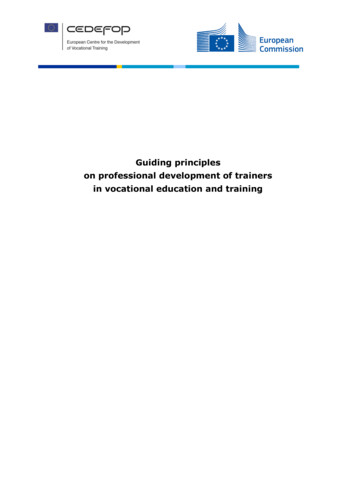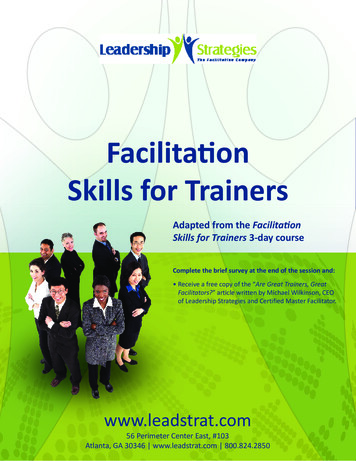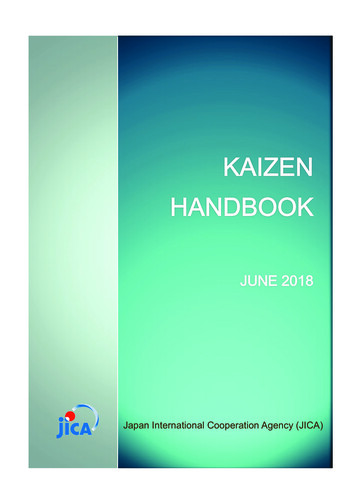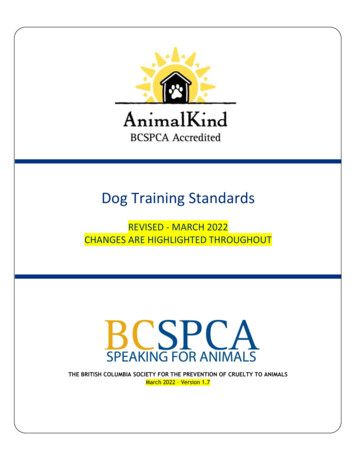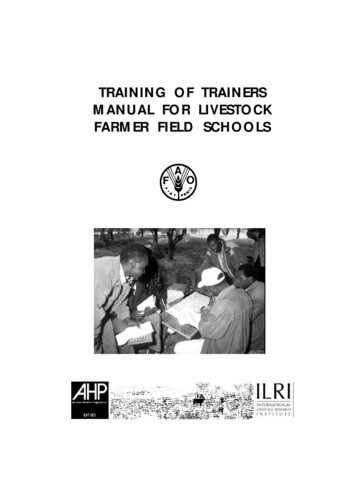
Transcription
TRAINING OF TRAINERSMANUAL FOR LIVESTOCKFARMER FIELD SCHOOLS
TRAINING OF TRAINERS MANUAL FORLIVESTOCK FARMER FIELD SCHOOLSCompiled by:Bruno MinjauwContributors:FFS methodology and principles:Godrick KhisaDorothy MayeBenjamin MweriParticipatory EpidemiologyAndy CatleyBased on a participartory workshop held on the17 t h TO 29t h SEPTEMBER 2001,MABANGA FTC, BUNGOMA,Kenya
ContentsPreface . 2Part 1 TRAINING OF TRAINERS ORGANISATION .41.1 Logistics . 41.1.1 Workshop invitation . 41.1.2 Venue . 41.1.3 Classroom and teaching facilities . 41.1.4 Participants . 41.1.5 Grouping . 51.1.6 Documentation . 61.2 Facilitation principles . 61.2.1 Participatory introduction by the participants . 71.2.2 Levelling of Expectations . 81.2.3 Setting of learning norms . 91.2.4 Functions of host team . 101.2.5 Commissions . 10Part 2 FARMER FIELD SCHOOL PRINCIPLES .122.1 Background . 122.2 Approach and Concept . 132.3 Objectives of Field Schools . 142.4 Principles of Farmer Field Schools . 152.5 Characteristics of the Farmer Field School . 162.6 Key concepts underlying the FFS approach . 18Part 3 FFS methodology .203.1 Steps in Conducting FFS (classical approach) . 203.2 Concept of Eco-system . 223.2.1 Tropic levels in the livestock ecosystem . 223.2.2 The disease triangle . 233.2.3 Transect walk in a grazing field . 233.2.4 Concept of what is this? What is that? . 243.2.5 Feedback from Fieldwork/Appreciating types of ecosystem . 293.2.6 Agro-Eco-System Analysis (AESA) – making a group management decision . 293.2.7 Principles of Integrated Livestock Management . 33Part 4 ORGANIZATION and Management of Farmer Field Schools .364.1 Project Conditions for a sustainable FFS . 364.2 Groundwork . 374.3 FFS Curriculum . 384.3.1 Content . 384.3.2 Field school schedule . 394.3.3 Lessons learnt in farmer field school . 404.3.4 Conditions for successful FFS . 41
Part 5 FFS participatory methodology and Techniques . 425.1 Introduction to Non-formal Education . 425.1.1 Definition of “ learning” . 425.1.2 Basics facts about adult learning processes . 425.2 Types of non-Formal Education Approaches used in FFS . 435.2.1 Sharing . 435.2.2 Case study . 435.2.3 Role-play. 435.2.4 Problem Solving Exercise . 445.2.5 Panel Discussion (as a method for presenting case studies) . 445.2.6 Group dynamics . 455.2.7 Small group and big group discussion . 455.2.8 Brainstorming . 465.2.9 Simulation game . 475.2.10 Ballot box exercise: Evaluating knowledge and skills . 475.3 Participatory discussion on Folk Media . 495.4 Participatory technology developement . 515.4.1 Definitions . 515.4.2 Considerations in Establishing PTDs In FFS Sites . 515.4.3 Steps in Establishing PTD in TOT and FFS Sites . 525.4.4 Livestock participatory technology development . 55Part 6 Participatory Epidemiology . 586.1 Introduction . 586.2 Overview of participatory methods . 596.3 Working as a team when using participatory methods . 596.4 Interviews for participatory epidemiology . 606.5 Using picture and other aids to assist PE methods . 626.6 Participatory Mapping . 646.7 Seasonal calendars . 676.8 Matrix scoring . 726.9 Proportional piling . 76ANNEX 1 Group dynamic exercises. 80ANNEX 2 Programme . 103ANNEX 3 List of Participants . 106
stem AnalysisCommunity based Animal health and ParticipatoryEpidemiology unitContagious bovine pleuropneumoniaDistrict officerDistrict Agricultural OfficerDistrict Extension OfficerDepartment For International DevelopmentFood and Agriculture OrganisationFarmer Field SchoolFoot and mouth diseaseFarmer Training CentreInternational Institute for Environment and DevelopmentInternational Livestock Research InstituteIntegrated pest managementKenya Trypanosomiasis Research InstituteNon-formal educationNon- governmental organisationOrganisation of African Unity/ Inter African Bureau foranimal resourcesPan African programme for the control of EpizooticsParticipatory Action ResearchParticipatory epidemiologyparticipatory appraisalParticipatory technology developmentTraining of trainersUnited Nations Development Programme1
PREFACEThe FFS approach was developed in the late 80’s by FAO in South East Asiaas a way for small-scale rice farmers to investigate, and learn forthemselves the skills required for, and the benefits to be obtained fromadopting integrated pest management (IPM) practices in their paddy fields.Since then, the approach has been extended to several countries in Asia,Africa and Latin American. At the same time there has been a shift fromIPM for rice-based systems towards other annual crops and vegetables andintegrated soil fertility management. The number of FFS in the world hasrisen greatly but the question still remains unanswered whether the FFSextension approach would be suited in even more complex situations whereno quick responses may be expected such as animal health and husbandry.The animal health programme of the Department For InternationalDevelopment (DFID-UK) and FAO decided to support a research anddevelopment project lead by the International Livestock Research Institute(ILRI) to adapt the Farmer Field School methodology for livestockproduction systems. The present manual is the first output of this projectand the product of a participatory workshop on the training of trainers(TOT) for livestock FFS held on the 17-29 September 2001, Mabanga FTC,Bungoma, Kenya. This manual is a compilation of notes taken during theworkshop, existing FFS TOT reports (from FAO FFS co-ordinators: G. Khisa,D. Maye and B. Mweri,) and participatory epidemiology handouts from theAU/IBAR Cape Unit (Dr. A. Catley)The FFS approach is, in most circumstance a major change in attitude andapproach to extension service. It is essential that extension officers thatwill conduct FFS are trained to understand the philosophy, principles andmethods underlying the FFS approach. The conventional extension agentshave been trained in a traditional manner based on a “top-down” approach.This approach is contrary to the FFS philosophy, which emphasisesparticipatory approaches. Consequently, the attitudes and skills of mosttrainers will need to be radically modified if they are to be successfullytransformed from being instructors to becoming facilitators. Thistransformation is the main objective of the Training of Trainers. Instructorsimpart knowledge to farmers who adopt a passive role of receivinginformation. In contrast, a facilitator creates conditions for farmers tolearn, in observing and interpreting differences in productivity, in carryingout simple experiments and exercises and through discussions.2
The facilitator encourages farmer to adopt an active role in the learningprocess.The manual has been designed as guide and source of material for FFSfacilitators in charge of organising a Training of Trainers (TOT). Although thebasic principles are identical, this manual differs slightly from other FFSmanuals as it gives specific examples for livestock production systempurposes. The TOT was therefore run as a learning workshop whereparticipants learned and at the same time developed adaptation of thebasic principles suitable for the smallholder dairy production system. TheTOT was not a refresher course on animal production and health issues,therefore no technical information is included in this manual. The majordifference between crop and livestock FFS resides in the understanding ofthe impact of animal health issues to productivity and how to controldisease occurrence. A specific chapter on participatory methods modifiedfor basic epidemiology studies provides assistance to facilitators tointegrated animal health activities in their FFS programme.3
Part 1TRAINING OF TRAINERS ORGANISATION1.1 Logistics1.1.1 Workshop invitation Arrange for all invitations to be sent out well in advance, togetherwith workshop agendasArrange for travel permits and tickets to be sentEnsure all participants know what is expected of them, including thetimings of the workshop and if expenses or a per diem will be paid.1.1.2 Venue The venue will preferably be in a relatively isolated place whereparticipants will not be disturbed by urban activities.Accommodation should be close to workshop facilities and providedfor everyone throughout the training.The food should be of sufficient quality and quantity to satisfy theparticipants. The biggest complaints in workshops are often aboutfood.If possible, the workshop will be situated near existing FFS to enablefield exercises and visits. Field visits can also be organised inneighbouring farms independent of their involvement in FFS or not.Since participants are divided into sub-groups, means of transportwill have to be provided for independent field trips.1.1.3 Classroom and teaching facilities Since the course runs for 2 weeks, it is important to have aminimum of two master FFS trainers and reasonable communicationand accommodation facilities.The seating arrangement should be a cluster of tables reflecting thesub-group, allowing the trainers to walk easily amongst group.Are a slide projector, video player and overhead projector available?What about the electricity supply?Are flipcharts, newsprint, pens and paper available.1.1.4 ParticipantsAll the participants should have a similar background and if possibleinvolvement in livestock extension programmes. The optimal number ofparticipants is considered to be 20 and it is not advisable to run a TOT withmore than 30 participants.4
Some essential information about the participants is needed beforeproceeding with the TOT (Source: IIED; 1995): How many people will be present? Why are they attending; is it their own choice or has a superiorinstructed them to be present? What are their fears and concerns? What range of experience, discipline, age, gender, status is likely tobe represented? Do they have any biases towards or against you or yourorganisation? What prior knowledge might they have about the subject matterof the training?Participants should be selected for their ability to acquire the skills andthe main features of attitude and role of a facilitator: To accept that there is no monopoly of wisdom or knowledge To listen to farmers and respect their knowledge, experiences andperceptions To give farmers the confidence to share their knowledge andexperiences To create suitable conditions and activities from which farmers canlearn To be responsive to farmers’ needs and flexible in organising thecourse To increase farmers’ knowledge, problem-solving ability, capacity forinnovation and skills so that the role of the facilitator is changedwith time from that of facilitator to coordinator1.1.5 GroupingThe group of participants represent a fictitious FFS group and are groupedrandomly into sub-groups of /- 5 participants. Each group givesthemselves a name and a slogan. Each sub-group or team perform all tasksassigned by the facilitators in there respective groups. When presentingtheir output to the plenary they call out their slogan and the rest of thegroup respond. Example:TEAM NAME1. Bidii2. Friesian3. Ayrshire4. JerseySLOGANNanguvuMaziwaChampionMore creamTEAM LEADERJ.C.JohnAnthonyFrancis5
1.1.6 DocumentationHandouts and relevant materials should be prepared for each participant. Itis better that they listen or participate than write notes during sessions.Materials for exercises and group dynamics should also be prepared inadvance.It is essential to give each participant a minimum of stationary (pen, pencil,eraser and note book) for his or her individual work.1.2 FACILITATION PRINCIPLESPrior to carrying out participatory introduction by participants, thefacilitation principles and core value of FFS are expanded to theparticipants as follows:The basic methods to be used in the TOT and in FFS are presented and aresummarized as below: Visualization Group dynamics Large and small group discussions Informal and structured discussions Field visits6
1.2.1 Participatory introduction by the participantsObjectives To discover what participants want to get from the session,workshop or training course and learn a little about theirpersonalitiesTo help evaluate the course at the end of the trainingTo help participants relax at the beginning of the courseProcedure1. Split participants into pairs. Ask each participant to interview theirpartner by focusing on questions such as: What is your name? What is your background and experience? Why are you attending this course? What do you hope to get from it? Do you have any past experience of participatory methods in thefield? Name two good things that happened to you in the past year.2. After five minutes of interviewing each other, participants then report toplenary about their partner, summarising the main information in oneminute.7
CommentsThe key to the exercise is that participants do not report on themselves in this way they not become nervous while waiting for their turn. In addition,the exercise is neutral to seniority; neighbouring participants interview eachother - you as the trainer may find only later that a junior officer isreporting on a director or vice versa.1.2.2 Levelling of ExpectationsEach group answers the 2 first questions presented below. A summaryposter is prepared by the host team and decorates the classroom for theentire course. The facilitators also present their own expectations. What are the expectations of the participants from the course? What are the expectations of the participants from the facilitators? What are the expectations of the facilitators from the participants?If expectations have been discussed, the trainer can write these down onflipchart paper, which can then be stuck to the wall during the workshop.Participants are then able to use the list to monitor whether theirexpectations have been met or not or have changed.RemarksYou may find that this exercise is also valuable for evaluations. To use it forthat purpose, change the questions that the pairs ask of each other to: To what extent did the course meet my (your) expectations?’ ‘What did you find most valuable?” What did you find least valuable? How would you like to see the course changed before it is run again?Example of expectations of the participants from the course 8Fully understand the concept of the FFS and the skills required torun them.How to identify and form a group and run FFS.Learn how to develop a curriculum and networking of participantsLearn how to incorporate FFS approach in scaling integratedlivestock management technologiesGroup dynamicsLearn techniques of sustaining the farmer led FFSAcquire skills in training other trainersColourful graduationCertificate of participation to be given
Examples of expectations of the participants from thefacilitators Learn about FFSAcquire new extension methodologyExpect certificates at the end of courseClarity in presentationA well presented handoutPractical field experiencePackage on group formationHighly qualified professionalsTime conscious teamFinancial facilitationExamples of expectations of the facilitators from theparticipants CommitmentCooperationRespect opinionsExchange of experienceDiscovery based farming1.2.3 Setting of learning normsFor their two weeks stay at the training venue, participants develop theirown learning norms (rules). Each team prepares 3 norms and the list iscompleted by open discussion.Example of norms set by participants: All sessions must start with a prayer and a motto for the groupPunctuality should be observedParticipation through discussion and presentation withoutintimidationAbsenteeism without permission not allowedMembers should be alert and respect each other’s opinionNo drinking or smokingNo wrong answersUse understandable language with one speaker at a timeCollective responsibility with democratically elected leadersMinimal movement during sessionGroup assignment taken seriouslyClose with a prayer9
1.2.4 Functions of host teamThe process of sharing responsibilities and participating in the TOT areoutlined in the functions of host teams, where each group is responsible forthe days activities on a rotational basis and additional responsibilities inthe farming tasks assigned per commission as below.The host team should: Facilitate the whole week/day(s) activities Prepare the opening program and schedule of activities Arrange the training venue Keep the training hall and premises clean Provide the energiser/ice breaker exercises to relax the atmosphere Introduce the resource person/guest speaker Check the weekly attendance of the FFS PAR Serve as the timekeeper Distribute the reading and other materials Assist the FAX or reporter in the reporting and discussion Do other functions assigned by FAX1.2.5 CommissionsEach sub-group has a responsibility for the day. Every day the task changesfor each group. Example:Group 1 – BidiiGroup 2 – FriesianGroup 3 – AyrshireGroup 4 – Jersey10Disciplinary mattersEntertaining and cateringNews and cleanlinessLogistics and Communication
11
Part 22.1FARMER FIELD SCHOOL PRINCIPLESBACKGROUNDThe FFS approach was developed by an FAO project in South East Asia as away for small-scale rice farmers to investigate and learn, for themselves theskills required for, and benefits to be obtained from, adopting practices intheir paddy fields.The term “Farmer Field School” comes from the Indonesian SekolahLampangan meaning simply “field school”. The first Field Schools wereestablished in 1989 in Central Java during the pilot phase of the FAOassisted National IPM Programme. This Programme was prompted by thedevastating insecticide-induced outbreaks of brown plant hoppers(Nilaparvata lugens) that are estimated to have in 1986 destroyed 20,000hectares of rice in Java alone. The Government of Indonesia’s response wasto launch an emergency training project aimed at providing 120,000farmers with field training in IPM, focused mainly on recording on reducingthe application of the pesticides that were destroying the natural insectpredators of the brown plant hopper.The technicalities of rice IPM were refined in 1986 and 1987 and a corecurriculum for training farmers was developed in 1988 when the NationalIPM Programme was launched. It was based, not on instructing farmerswhat to do but on empowering them through education to handle there ownon-farm decisions, using experiential learning techniques developed for nonformal adult education purposes.Since then, the approach has been replicated in a variety of settings beyondIPM. The FARM Programme (FAO/UNDP), for example, has sought to adaptthe FFS approach to tackle problems related to integrated Soil FertilityManagement in the Philippines, Vietnam and China. The themes studied byfarmers’ groups include soil mapping of village lands, physical and chemicalanalysis of soils, fertilizer application and the influence of cropping practiceson fertility. With the knowledge thus gained, farmers can more easilyrecognize differences in soils and take better informed decisions on the useof organic and inorganic fertilizers, alternative tillage systems and croppingpractices so as to improve the conservation and management of soilproductivity.12
Subsequently the FFS approach has been extended to several countries inAfrica and Latin American. At the same time there has been a shift fromIPM for rice-based systems towards other annual crops and vegetables. Thecurriculum has been enriched with other crop management aspects.In Kenya, the approach was introduced in 1995 under the special Programme for food security on maize based farming systems with only 4 FFSschools in Kakamega District, Western Province. The number has since risento over 500 FFS spread over in Western, Coast, and Central province.The question that still remains unanswered is whether the FFS extensionapproach would be suited in even more complex situations where no quickresponses may be expected such as animal health and husbandry. Theanimal health programme of DFID and FAO are funding the present project,executed by the International Livestock Research Institute (ILRI), to developand adapted the FFS methodology for dairy production system.2.2APPROACH AND CONCEPTFarmer field schools (FFS) are a participatory approach to extension,whereby farmers are given opportunity to make a choice in the methods ofproduction through discovery based approach.A Field School is a Group Extension Method based on adult educationmethods. It is a “school without walls” that teaches basic agro-ecology andmanagement skills that make farmers experts in their own farms.It is composed of groups of farmers who meet regularly during the courseof the growing seasons to experiment as a group with new productionoptions. After the training period, farmers continue to meet and shareinformation, with less contact with extension workers.FFS aims to increase the capacity of groups of farmers to test new technologies in their own fields, assess results and their relevance to theirparticular circumstances. They interact on a more demand driven basis withthe researchers and extension workers, looking to these for help where theyare unable to solve a specific problem amongst themselves.In summary a Farmer Field School (FFS) is a forum where farmers andtrainers debate observations, apply their previous experiences and presentnew information from outside the community.13
The results of the meetings are management decisions on what action totake. Thus FFS as an extension methodology is a dynamic process that ispracticed and controlled by the farmers to transform their observations tocreate a more scientific understanding of the crop/livestock agro-ecosystem. A field school therefore is a process and not a goal.2.3OBJECTIVES OF FIELD SCHOOLSBroad ObjectivesTo bring farmers together to carry out collective and collaborative inquirywith the purpose of initiating community action in solving communityproblemsSpecific Objectives To empower farmers with the knowledge and skills to make themexperts in their own fields.To sharpen the farmers’ ability to make critical and informed decisionsthat render their farming profitable and sustainable.To sensitise farmers in new ways of thinking and problem solving.Help farmers learn how to organize themselves and their communities.FFS also contribute to the following objectives: Shorten the time it takes to get research results from the stationsto adoption in farmers’ fields by involving farmers’ experimentationearly in the technology development process. Enhance the capacity of extension staff, working in collaborationwith researchers, to serve as facilitators of farmers’ experientiallearning. Rather than prescribing blanket recommendations thatcover a wide geographic area but may not be relevant to all farmswithin it, the methods train extension workers and researchers towork with farmers in testing, assessing and adapting a variety ofoptions within their specific local conditions. Increase the expertise of farmers to make informed decisions onwhat works best for them, based on their own observations ofexperimental plots in their Field schools and to explain their reasoning.No matter how good the researchers and extensions,recommendations must be tailored and adapted to local conditions,for which local expertise and involvement is required which onlyfarmers themselves can supply.14
2.4Establish coherent farmer groups that facilitate the work ofresearch a
TRAINING OF TRAINERS MANUAL FOR LIVESTOCK FARMER FIELD SCHOOLS Based on a participartory workshop held on the 17 th TO 29 SEPTEMBER 2001, MABANGA FTC, BUNGOMA, Kenya Compiled by: Bruno Minjauw Contributors: FFS methodology and principles: Godrick Khisa Dorothy Maye Benjamin Mweri Participatory Epidemiology Andy Catley

